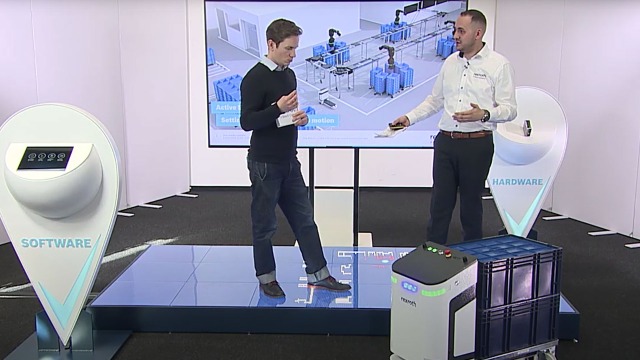



One of the core tasks of intralogistics is to optimize the material flow from the source to the destination and point of use. After all, the more efficient the material flow, the fewer stocks need to be held for production, reducing the volume of tied up capital. With ActiveShuttle, we have developed an autonomous mobile robot (AMR) to increase efficiency in intralogistics, decrease stocks and clear up temporary storage space.

In our robotics webcast, Victor Robertus explains how the ActiveShuttle increases efficiency in intralogistics and how easy it is to use.
Usually, transport tasks in intralogistics are still carried out manually, be it individually or in milk runs. Most intralogistics concepts center around continuously supplying work stations with the required material. This is why in addition to the central warehouses, most factories have warehouses close to production as a buffer – which in turn increases stocks. With ActiveShuttle, we have developed an autonomous mobile robot (AMR) to increase efficiency in intralogistics, decrease stocks and clear up temporary storage space. This ensures timely and automated replenishment at the assembly lines.
One well-known concept is the lean provision of components and assemblies using a tugger train. However, this process has a number of disadvantages. First, semi-automatic or manual loading and unloading of the tugger trains can result in low capacity utilization. Second, the movement of goods can increase the risk of accidents for people and other transport systems. Transport requirements often have to be recorded manually, which can result in longer replenishment times and incorrect part deliveries. In this case, requests to an ERP system are not sent or are delayed. One core issue is ensuring that the warehouse is informed of requirements on time in order to guarantee that the assembly lines are replenished in a timely manner.
This is what the use of the ActiveShuttle looks like in practice: It receives a transport task and drives to the picking station in the central warehouse. There, it picks up a dolly equipped with small load carriers and transports it directly to its destination, dropping it at a supermarket or at a workstation, for example. On its return journey, ActiveShuttle transports empty containers or containers filled with processed parts to the next destination.
Thanks to our Locator, a software component for reliable location and orientation assistance, the ActiveShuttle can find its way in any natural environment. Neither infrastructural changes nor expert knowledge are required for commissioning – all it takes is one manually controlled tour of the plant. On this first drive, the ActiveShuttle creates a map of its environment, which is saved to the vehicle or to a server. If several vehicles are in use, they all use this same map. They can then immediately identify their location without any prior knowledge. When a vehicle notices a change in the environment, for example because a new storage space has been set up, it will communicate the information to the server, and the server will automatically update the map and pass it on to all other vehicles in the fleet. Vehicles that are subsequently integrated will use the Locator to obtain server data during the commissioning process and can start to work immediately.
The ActiveShuttle Management System is responsible for coordinating the ActiveShuttles, live mapping and assigning the individual transport tasks. Via open standards, it communicates with all widely-used inventory management systems or the company’s software.
Acquainting the ActiveShuttle with its environment and controlling it is fairly simple. Using any end device, operators open the web-based, intuitive interface with a familiar menu structure. They start the orientation drive from the start menu and connect the vehicle to the ActiveShuttle Management System. No programming knowledge is required for this.
In daily operation, everything runs automatically. From their desks, intralogistics workers can access evaluations of individual vehicles or the entire fleet. Live mapping offers them a complete overview at all times and allows them to transparently retrace every single transport task.
Would you like to know more? Have a look at our robotics webcast.